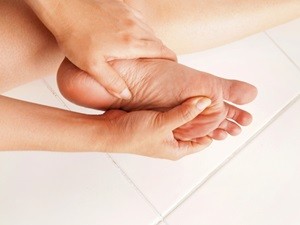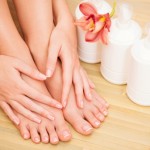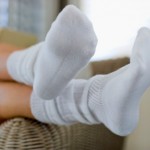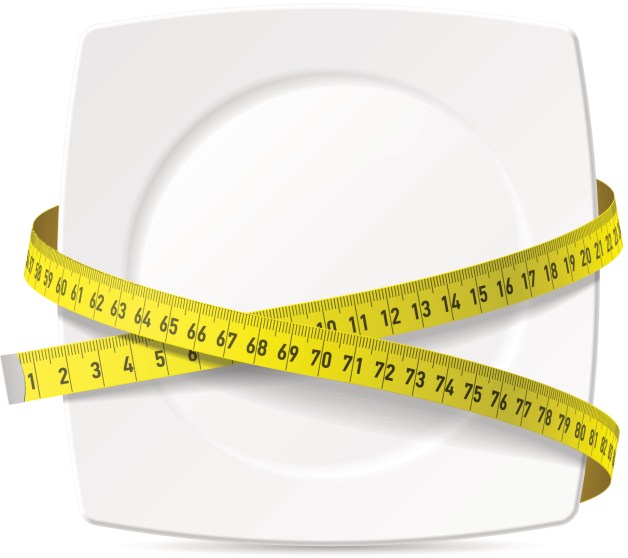Stride healthy: Foot care for diabetics
 Diabetics have a lot on their plate. They’re thinking about blood sugar control, following their medication, exercising, watching their carbohydrates and eating right… The list goes on.
Diabetics have a lot on their plate. They’re thinking about blood sugar control, following their medication, exercising, watching their carbohydrates and eating right… The list goes on.
But feet and diabetes are not always top of mind. We need to change that and put diabetes foot care on the radar.
Good management of your diabetes and an overall healthy lifestyle help to keep this disease under control. That includes following some proper diabetic foot care guidelines. For diabetics, the nerve damage, circulation problems, and infections can lead to serious foot problems. You want to stop those in their tracks – no pun intended.
Why foot care is important for diabetes
 Diabetes takes a toll on the nervous system and circulation. It can reduce the blood supply to your feet and cause a loss of feeling from nerve damage known as peripheral neuropathy. This also can mean foot injuries and skin ulcers do not heal well. Worse still, you may not notice if your foot is sore or injured.
Diabetes takes a toll on the nervous system and circulation. It can reduce the blood supply to your feet and cause a loss of feeling from nerve damage known as peripheral neuropathy. This also can mean foot injuries and skin ulcers do not heal well. Worse still, you may not notice if your foot is sore or injured.
If foot ulcers do develop, it’s crucial to get prompt care. A non-healing ulcer that causes severe damage to tissues and bone may require surgical removal – amputation – of a toe, foot or part of a leg.
The good news is that careful diabetes management and diabetes foot care can help prevent foot problems. Better diabetes care is probably why the rates of lower limb amputations have gone down by more than 50 percent in the past 20 years, according to the Mayo Clinic.
The risk of complications can be greatly reduced if you’re able to bring your blood sugar levels under control. That also means ensuring that your blood pressure and cholesterol levels are monitored and controlled with medication if needed.
Foot care tips and guidelines
 As we’ve said, you can do a lot to avoid serious complications for your feet by following diabetic foot care guidelines. We’ve rounded up the top foot care tips for diabetics, starting with what you should do on a daily basis to be good to your feet:
As we’ve said, you can do a lot to avoid serious complications for your feet by following diabetic foot care guidelines. We’ve rounded up the top foot care tips for diabetics, starting with what you should do on a daily basis to be good to your feet:
Inspect your feet. Check your feet and toes every day for blisters, cuts, cracks, sores, redness, tenderness or swelling. If you discover anything, see your doctor immediately. If you have difficulty, use a hand mirror to see the bottoms of your feet, or place the mirror on the floor.
Be mobile. To promote good circulation, don’t sit with your legs crossed or stand in one position for long periods of time.
Wash your feet. Wash your feet in warm water with mild soap. Hot water and harsh soaps can damage your skin. Check the water temperature with your hand before putting your feet in. because your diabetes may make it difficult to sense the water temperature with your feet. Dry them gently and well, especially between the toes. Use talcum powder or cornstarch between your toes to keep the skin dry; infections tend to develop in moist areas. Apply moisturizer on the tops and bottoms of your feet to keep the skin soft.
Keep these foot care tips for diabetics in mind at all times:
Don’t remove calluses or other foot lesions yourself. To avoid injury to your skin, don’t use chemical wart removers or nail clippers or scissors on calluses, corns, bunions or warts. See your doctor or foot specialist for safe removal.
Trim your toenails carefully. Leave this to your foot specialist for best results. But if you do them yourself, trim your nails straight across and file sharp ends with an emery board. Be careful not to cut nails too short.
Protect your feet with socks and shoes. You don’t want to go barefoot, even at home. If you have nerve damage that has affected foot sensitivity, you may overlook cuts or bumps. Protect your feet by wearing clean, dry socks. Choose the sweat-wicking type to keep your feet dry, such as cotton and acrylic fibers. And avoid those with tight elastic bands that reduce circulation.
Wear proper fitting shoes. Choose comfortable shoes with good support. Avoid the risks of tightfitting shoes and high heels or narrow shoes that crowd your toes. Do not wear shoes made out of plastic or other materials that do not breathe. Try orthopedic shoes to fit the exact shape of your feet, cushion your feet and evenly distribute weight on your feet.
Quit smoking! Smoking is bad for diabetics because it impairs circulation and reduces the amount of oxygen in the blood. Circulation problems can affect the healing of wounds or injuries.
Get regular foot checkups. These are important. Your doctor or podiatrist can check for early signs of nerve damage or other foot problems. Have a foot exam at least once a year.
Foot injuries are serious. Don’t delay, see your doctor if you have a foot sore that doesn’t quickly begin to heal or you experience any other persistent problems. You want a prompt diagnosis and appropriate course of treatment.
Developing good lifestyle habits are all part of managing your diabetes. You want to be kind to your feet and take good care of them. Follow these foot care tips for diabetics and you’ll be walking healthy for years to come.
-
HCG Shots Are Very Efficient And Highly Affordable
HCG Injections is really a certainly one of a type injection solu
-
What You Really Need To Know About Weight Management And Diets
Dont Make Weight Management So Complicated!Hundreds--if not thousands-
-
Best Weight Loss Tips - You Can Win The Weight Loss War
No weight loss war can be won without the right implementation of exer
-
Free Weight Loss Advice That Really Works!
Heres your first weight loss nugget: Just because somebody has muscle
-
Sarcoidosis, a kidney stones risk, diagnosed better using blood monocytes
Sarcoidosis, known as a kidney stones risk, could be better di
-
Get Rid of Cellulite Through Exercise!
Cellulite, or the trapped fat that we ca
- DON'T MISS
- Need To Drop A Few Pounds? These Tips Can Help!
- Make Diet Plans and Weight Loss Programs Work For You
- Top 3 Weight Loss & Fitness Trends in 2009
- How to lose weight with the help of a banana
- Safe Effective Weight Loss with Little Effort
- Weight Loss Tip Attack Body Fat
- How to Diet Successfully - 7 Top Tips for Staying on Track
- This Is The Healthiest State In The Country. Heres Why
- Burn Fat Now How I Lost 60 Pounds In 5 Months
- Lose Weight To Sleep Better




